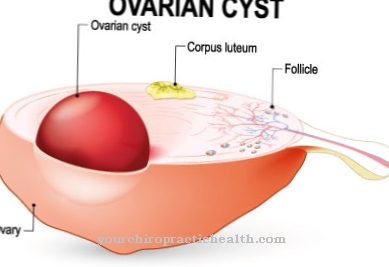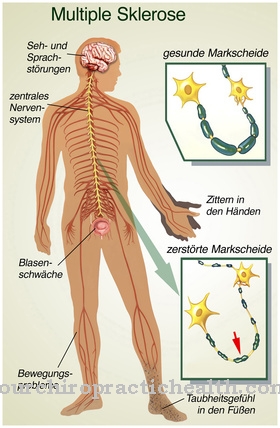Anorexia athletica is best with Sports anorexia translate. Athletes starve to perform better, but this puts their health at risk.
What is anorexia athletica?

© staras - stock.adobe.com
Sports anorexia mostly occurs in those disciplines in which slimness (rhythmic gymnastics, figure skating) or low weight (ski jumping, long distance running, triathlon) are an advantage. Sports in which the weight class is decisive (boxing, judo, wrestling) are also affected.
The urge to lose weight can turn into an eating disorder. Ski jumpers and girls and women who practice rhythmic gymnastics are particularly at risk. Anorexia athletica is not only harmful to health, it also reduces performance. The low food intake affects concentration and causes problems with the circulation and low blood pressure.
Anemia and immune deficiency set in. The reduction in body weight leads to a decrease in bone density and this leads to an increased risk of injury. When athletes train hard and lose weight too much, menstruation can stop (secondary amenorrhea).
causes
Athletes are more prone to eating disorders than other people, and body weight plays a special role in some sports. Cyclists as well as long-distance runners, mountain runners and ski jumpers have advantages if they weigh less. In the sports of gymnastics, rhythmic gymnastics and figure skating, low weight promotes mobility.
In addition, the assessment of the athletes' appearance is crucial for success. Since slimness is equated with beauty and grace, the athletes begin to starve in order to conform to the aesthetic ideals. Women, especially girls and young women, are more prone to anorexia athletica than men.
In addition, there must be a tendency to starvation so that athletes develop disrupted eating behavior. The causes are not only to be found in the described requirements of the respective sport, but also in individual personality traits (pronounced ambition, low self-esteem).
Symptoms, ailments & signs
Fluctuations in weight and severe weight loss are clear symptoms. Conspicuous eating behavior and the compulsion to exercise should be taken seriously as indications of both professional athletes and ambitious amateur athletes.
Young people are often affected by anorexia athletica: If puberty does not set in or if it is delayed, this can be a sign of anorexia. The often repeated assertion that they do not want to get fat and the attempt to conceal or trivialize their disturbed eating behavior are further alarm signals for young athletes.
It has already been mentioned that severe weight loss can lead to a decrease in bone density and osteoporosis as well as to menstrual disorders in girls and women. The inadequate supply of nutrients also manifests itself in changes in the structure of the skin, in brittle nails, brittle hair and hair loss. Imbalance, susceptibility to illness and loss of performance are also signs that the energy balance is disturbed.
Diagnosis & course
Sports anorexia begins unobtrusively and is hardly noticed by other people, as the majority of athletes are characterized by a low weight and low body fat percentage. A low BMI (Body Mass Index) does not necessarily have to be a sign of anorexia athletica, but can also be due to predisposition or other factors.
However, when it comes to food cravings in the course of which meals with over 1500 calories are consumed, then the eating disorder can hardly be denied. Questionnaires and tests about eating behavior, as well as continuous weight checks and observance of signs of osteoporosis, enable a reliable diagnosis.
Complications
Electrolyte imbalances can occur as a complication of anorexia athletica. The effects are very different. Severe electrolyte disturbances can lead to quantitative disturbances of consciousness up to a coma, but also cause seizures and cardiac arrhythmias. In addition, functional disorders of nerves, muscles and the digestive tract are possible.
To prevent these complications, adequate food intake and a reduction in physical activity are necessary. Excessive exercise increases the risk of injury. Restricting food intake at the same time can lead to fatigue and poor concentration, which make injuries during exercise even more likely.
Other physical complications of anorexia athletica arise from behaviors that affect other aspects of the eating disorder. Abuse of laxatives can also cause electrolyte imbalances and long-term damage to the digestive system. Objective binge eating and reactive eating can also cause cardiovascular symptoms. The so-called refeeding syndrome comprises various cardiovascular complaints, which in rare cases can be life-threatening.
In addition, many people who suffer from anorexia athletica suffer from nutritional deficiencies. This can lead to both physical and psychological problems. A common long-term consequence is osteoporosis, which is due to a lack of calcium. The cognitive impairments are usually reversible. These include, among other things, concentration and memory disorders.
Eating disorders often do not occur alone, but are in many cases accompanied by other psychological problems. This can be another disease (for example a personality disorder, anxiety disorder, obsessive-compulsive disorder, or mood disorder) or individual syndromes and symptoms.
When should you go to the doctor?
Anorexia athletica is a dangerous disease and should always be treated professionally. Although slimness has an advantage in certain sports, the athlete should not put his health at risk. If the low food intake is accompanied by symptoms such as poor concentration, circulatory problems and low blood pressure, the athlete should not shy away from contacting a doctor.
Anorexia athletica is usually accompanied by a nutritional deficiency that has negative effects on the health of the entire organism. Since the only way out of an eating disorder is usually not easy, this difficult path should be accompanied by specialists. Since eating disorders often do not appear as the only illness, but are usually accompanied by other mental disorders, a specialist in psychiatry is the right person to contact. The psychiatrist can get an overall picture of the disorder and initiate further treatment options.
The right therapy is selected by the psychotherapist or psychiatrist and always adapts to the personal characteristics of the person concerned. In addition to psychotherapy, nutritional therapy by nutrition experts is also recommended in order to normalize the nutritional style and lifestyle in the long term. Since competitive sport will no longer be possible in the future with severe forms of anorexia athletica, psychotherapy should prepare for a life without competitive sport.
Doctors & therapists in your area
Treatment & Therapy
First of all, increasing the calorie intake, weight gain and compensating for the lack of calcium, vitamin D and protein are central. It is also about improving bone density and bringing the menstrual cycle back into balance in women. In addition to a special diet, psychological advice and support is common.
The type of psychotherapy depends on the course of the illness and the personal preferences and characteristics of the person concerned. An important part of treatment is nutritional therapy, which serves to normalize and optimize diet and lifestyle in the long term. In severe cases, competitive sport will no longer be possible in the future due to the damage to health.
In this case, one focus of therapy is to prepare those affected for a life without competitive sport and to support them in realigning their lives. In this regard, care is taken to address and correct the relationship to sport and the relationship to one's own body as well as the associated self-image.
It is not uncommon for anorexia athletica to be sustained during an athletic career, not treated and maintained after the end of a career. The health risk remains as self-esteem continues to be promoted through the ability to control and mortify.
Outlook & forecast
The prognosis for anorexia athletica depends on the progression of the disease and the age of the patient. The sooner a diagnosis and treatment occurs, the better the chances of a cure. In addition, young patients have a better prognosis for recovery. Nevertheless, the chances of a complete cure in anorexia athletica are generally not very high. About a third of the sick manage to live a healthy life.
In addition, the chances of recovery depend on the patient's initial weight at the start of treatment. The lower the weight, the less likely a recovery becomes. Experience shows that even patients with early treatment often remain eating disorders for life.
In many cases, a secondary illness occurs as the disease progresses. This is usually the bulimia eating disorder. Patients experience food cravings and then vomit the food they have eaten again. A mental illness is also possible as a consequence. In addition, there is a risk that anorexia athletica will be fatal.
Malnutrition combined with heavy physical exertion from sports activities can lead to a breakdown with multiple organ failure. The body gradually dries out and can no longer meet the daily requirements. In chronically ill anorexics, the mortality risk increases to over 15% after a decade.
prevention
Anorexia athletica has long been taboo and banalized, but gradually a rethink is taking place and educational initiatives are being started. It can do the most in youth sports. However, all campaigns are of little or no help if the standards in various sports remain unchanged and low weight brings a competitive advantage.
Sanctions serve at least as a deterrent: In ski jumping, the problem of anorexia is combated by the fact that a BMI of 21 is currently specified in order to be able to use the full length of the ski (145 percent of the body height). If you fall below the value, you have to jump off with shortened skis.
Aftercare
If there is anorexia athletica, the patient absolutely needs follow-up care after initial treatment. The point is not to fall back into the old behavior patterns. Anorexia is problematic and difficult to treat anyway.
In anorexia athletica, the motives for the disease lie in addictive physical activity to achieve an athletic body. Those affected follow false ideals.After the acute treatment, the anorexic needs follow-up care in order to counteract such distorted body ideals.
In most cases of anorexia athletica, long-term psychological follow-up is essential. Self-help groups can also be used to permanently correct incorrect body conceptions and a disturbed self-image. If aftercare fails, substitute actions and other addictions can take the place of anorexia athletica. Worse still, the affected person can fall back into their old behavior.
Whenever exercise and eating disorders become addictive, there is something self-destructive about them. Acute treatment usually focuses on achieving a normal body weight. The task of aftercare is to treat the psychological component.
The patient must learn not to train to the point of collapse, but to respect his limits. He must not confuse the pursuit of success with being well trained. An important aftercare goal is to build a normal relationship with exercise and with your own body.
You can do that yourself
Since anorexia athletica is about consciously reducing the body weight of an athlete, the athlete and his trainer should inform themselves intensively and in detail about the natural conditions of the organism. The limits to permanent physical harm caused by eating behavior must be strictly monitored.
Weight reduction is often necessary before competition situations. Nevertheless, the duration of the deliberate change in eating behavior and the increase in training units must be observed. The behavior must be abandoned immediately after a competition. In addition, close cooperation and consultation with a sports doctor is always recommended when doing this. Together as a team, the natural needs of the body can be planned and worked out with those of achieving a sporting goal.
To avoid a subjective point of view as well as possible misjudgment and the resulting permanently damaging behavior, one should not act alone. The knowledge of a trained trainer and a doctor must be used.
In addition, a visit to the doctor is necessary at the first complications in order to make adjustments and changes to the eating and training plan. Failure to overlook the body's warning signals can lead to functional disorders and lifelong organic damage. It is therefore necessary to be particularly sensitive to instructions from one's own body, which must be followed immediately.





.jpg)


















.jpg)



